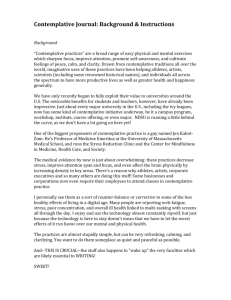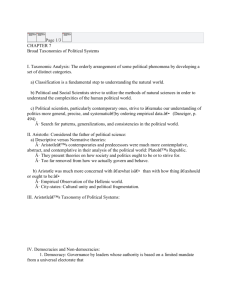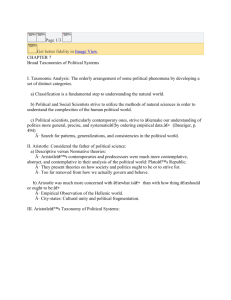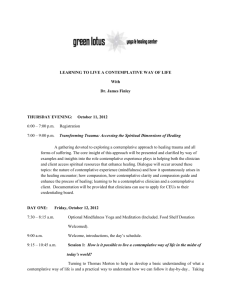How can contemplative education assist in helping compassion?
advertisement
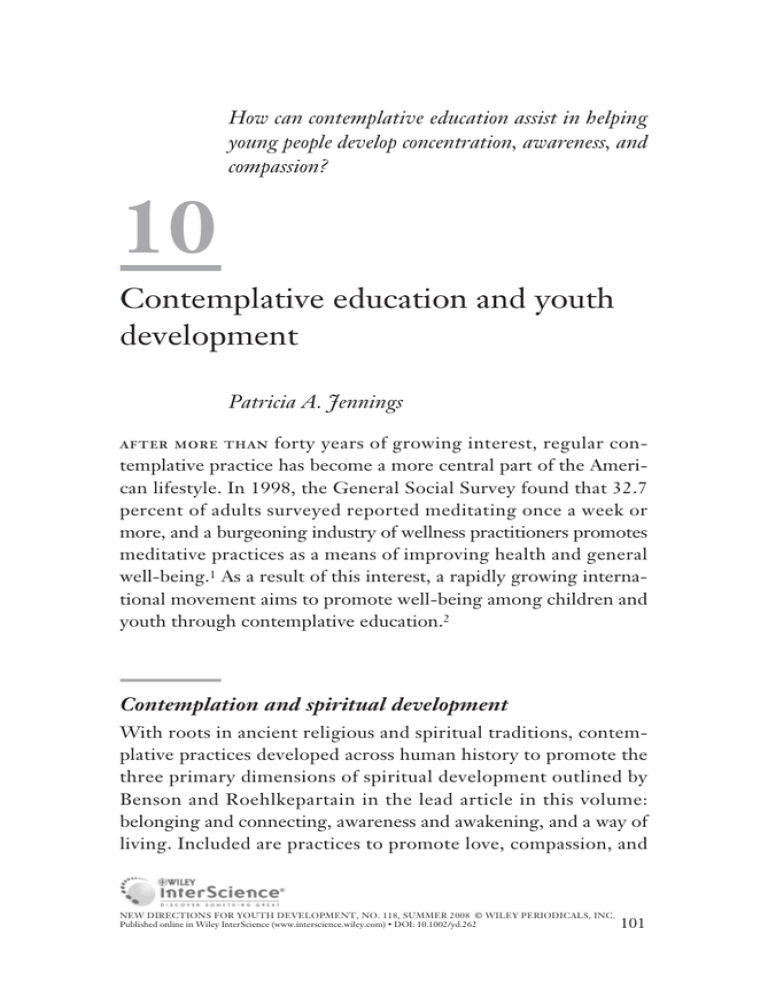
How can contemplative education assist in helping young people develop concentration, awareness, and compassion? 10 Contemplative education and youth development Patricia A. Jennings after more than forty years of growing interest, regular contemplative practice has become a more central part of the American lifestyle. In 1998, the General Social Survey found that 32.7 percent of adults surveyed reported meditating once a week or more, and a burgeoning industry of wellness practitioners promotes meditative practices as a means of improving health and general well-being.1 As a result of this interest, a rapidly growing international movement aims to promote well-being among children and youth through contemplative education.2 Contemplation and spiritual development With roots in ancient religious and spiritual traditions, contemplative practices developed across human history to promote the three primary dimensions of spiritual development outlined by Benson and Roehlkepartain in the lead article in this volume: belonging and connecting, awareness and awakening, and a way of living. Included are practices to promote love, compassion, and NEW DIRECTIONS FOR YOUTH DEVELOPMENT, NO. 118, SUMMER 2008 © WILEY PERIODICALS, INC. Published online in Wiley InterScience (www.interscience.wiley.com) • DOI: 10.1002/yd.262 101 102 SPIRITUAL DEVELOPMENT connection; to promote powers of concentration and enhanced awareness of self and other; and to bring awareness into the activities of daily living to promote a wholesome lifestyle. Contemplative practices can involve sitting quietly (such as in meditation), movement (such as yoga and tai chi), and the contemplation of nature or the arts,3 and they can be found in both the religious and secular realms.4 Contemplation as spiritual practice may be described as a developmental resource—the engine that drives spiritual development— because it promotes access to direct spiritual experience. Over time the practitioner develops a contemplative capacity—the ability to access and maintain contemplative awareness during contemplative practice and eventually within the activities of daily life.5 Evidence that children spontaneously experience contemplative states beginning in early childhood suggests that contemplation is a natural human capacity that can be nurtured through encouragement and practice.6 It also supports the argument that spiritual development is an intrinsic part of the human life span developmental process that begins early in life.7 Given the evidence that contemplative practices support valued developmental outcomes in adulthood, including spiritual development and improved attention, reduced stress, and increased prosocial responding, it is reasonable to assume that contemplation may promote equally valuable outcomes among children and youth.8 However, children are not just small adults; a careful examination of how contemplative practices may be introduced to meet developmental needs with attention to multiple domains (cognitive, biological, socioemotional, and spiritual) across each stage is required. To date, the empirical evidence to inform practice is extremely limited. A promising possibility is that well-designed contemplative interventions may promote the executive functions and self-regulatory capabilities found to be important prerequisites for children’s learning and caring for others. Contemplative practices may also support children’s quest for meaning and promote positive experiences of wonder and awe that motivate learning. new directions for youth development • DOI: 10.1002/yd CONTEMPLATION AND YOUTH DEVELOPMENT 103 Contemplative education As the number of contemplative practitioners grows, more teachers, parents, and school administrators are exploring ways to introduce contemplation in school settings to support mindful learning. Contemplative education refers more to how one learns than what one learns. In some cases it refers to how one unlearns unhealthy habitual patterns. Roeser and Peck define contemplative education as “a set of pedagogical practices that have as their aim personal and social transformation through the cultivation of conscious and willful awareness.” These practices help young people develop the self-awareness to recognize mental and behavioral habits and learn ways to transcend habitual patterns “in favor of more mindful and willful forms of living, learning, and relating to others.”9 Contemplation also may enhance learning by offering alternative ways of knowing that complement the rational and sensory. Hart argues that contemplative knowing is an important missing link that connects students to universally shared human values and an exploration of life’s meaning.10 Contemplative education has its roots in alternative educational methodologies, particularly in the United States, where the concern for division of church and state has been viewed as an obstacle to bringing contemplative education into mainstream public educational settings. The clear articulation of spiritual development as an essential human process outside the context of religion may alleviate this concern. Educational reformers such as Maria Montessori and Rudolf Steiner recognized the spiritual life and development of the child and designed methods of teaching to nurture this capacity from infancy through adolescence. In line with Montessori11 and Steiner,12 some argue that the introduction of contemplative practices to children should follow and nurture the child’s innate inclinations by providing opportunities for naturally occurring contemplation and infusing the curriculum with a contemplative orientation.13 Both of these educational philosophies offer examples of developmentally appropriate contemplative curriculum new directions for youth development • DOI: 10.1002/yd 104 SPIRITUAL DEVELOPMENT involving movement, the arts, the study of nature, and practicing silence. Montessori and Steiner point to the importance of the adult’s contemplative capacity in supporting children’s development. Parents and teachers with strong contemplative capacities can tune into the child’s natural inclination toward the contemplative and guide and nurture it by modeling contemplative behavior in everyday life. Such adults find skillful ways to weave the contemplative into their ordinary lessons rather than imposing a contemplative activity out of the context of the daily classroom rhythm. Contemplation may be a natural human capacity that begins early in life and can be nurtured through practice. It provides the practitioner an opportunity to directly experience the spiritual by promoting belonging and connecting, awareness, and a wholesome way of living. Contemplative education offers alternative ways of knowing and the potential for more mindful learning. However, developmental needs and capacities should be carefully considered when introducing contemplative practices to children and youth. Notes 1. Abeles, R., Ellison, C., George, L., Idler, E., Krause, N., Levin, J., et al. (1999). Multiple dimensions of spiritual experience. Kalamazoo, MI: Fetzer Institute. 2. Garrison Institute. (2005). Contemplation and education: A survey of programs using contemplative techniques in K-12 educational settings: A mapping report. Garrison, NY: Garrison Institute. 3. Caranfa, A. (2006). Voices of silence in pedagogy: Art, writing and selfencounter. Journal of Philosophy of Education, 40, 85–103. 4. Kesson, K., Traugh, C., & Perez, F. (2006). Descriptive inquiry as contemplative practice. Teachers College Record, 108, 1862–1880. 5. Trungpa, C. (1972). Meditation in action. Boston: Shambhala Press. 6. Hart, T. (2003). The secret spiritual world of children. Novato, CA: New World Library; Hart, T. (2004). The mystical child: Glimpsing the spiritual world of children. Encounter: Education for Meaning and Social Justice, 17, 38–49. 7. For example, Benson, P. L., Roehlkepartain, E. C., & Rude, S. P. (2003). Spiritual development in childhood and adolescence: Toward a field of inquiry. Applied Developmental Science, 7, 204–212; Kline, K. K. (2008). Authoritative communities: The scientific case for nurturing the whole child. New York: Springer; Roehlkepartain, E. C., King, P. E., Wagener, L. M., & Benson, P. L. (2006). new directions for youth development • DOI: 10.1002/yd CONTEMPLATION AND YOUTH DEVELOPMENT 105 The handbook of spiritual development in childhood and adolescence. Thousand Oaks, CA: Sage. 8. Murphy, M., & Donovan, S. (1999). The physical and psychological effects of meditation: A review of contemporary research with a comprehensive bibliography, 1931–1996. Sausalito, CA: Institute of Noetic Sciences. 9. Roeser, R. W., & Peck, S. C. (in press). An education in awareness: Human identity in contemplative perspective. Educational Psychologist. 10. Hart, T. (2002). Opening the contemplative mind in the classroom. Journal of Transformative Education, 2, 28–46. 11. Montessori, M. (1936). The secret of childhood. New York: Frederick A. Stokes. 12. Steiner, R. (1907). The education of the child. Great Barrington, MA: Anthroposophic Press. 13. Wolf, A. D. (1996). Nurturing the spirit in non-sectarian classrooms. Hollidaysburg, PA: Parent Child Press. patricia a. jennings is the director of the Initiative on Contemplation and Education at the Garrison Institute and holds a faculty position in Child and Adolescent Development at San Francisco State University. new directions for youth development • DOI: 10.1002/yd
